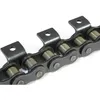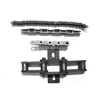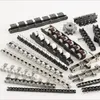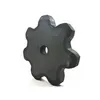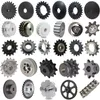Stainless steel chains are critical components widely used across various industries due to their exceptional durability, resistance to corrosion, and ability to perform under extreme conditions. These chains are manufactured from high-grade stainless steel, ensuring longevity and reliability in demanding environments such as marine, food processing, chemical, and outdoor applications. Our stainless chains are engineered to meet rigorous international standards, providing superior strength and minimal maintenance requirements.
Our stainless steel chains come in a range of specifications to suit diverse needs. Below is a detailed list of parameters:
| Chain Size (inches) | Diameter (mm) | Average Breaking Load (kg) | Weight per Meter (kg) | Recommended Use |
|---|---|---|---|---|
| 1/4" | 6.35 | 1,200 | 0.45 | Light-duty applications, decorative purposes |
| 3/8" | 9.525 | 3,500 | 1.02 | Marine hardware, general industrial use |
| 1/2" | 12.7 | 6,800 | 1.85 | Heavy lifting, construction sites |
| 5/8" | 15.875 | 10,500 | 2.90 | Rigging, towing, and agricultural machinery |
| 3/4" | 19.05 | 15,000 | 4.20 | Mining, oil and gas industries |
| 1" | 25.4 | 20,000 | 7.50 | Extreme heavy-duty applications, ship anchoring |
Stainless chains are versatile and used in numerous sectors. In the marine industry, they serve as anchor chains and for mooring due to their resistance to saltwater corrosion. In food processing, these chains are ideal for conveyor systems because they are easy to clean and non-reactive. The construction industry relies on them for lifting and securing heavy materials, while in chemical plants, they handle corrosive substances without degradation. Additionally, stainless chains are popular in decorative applications, such as fencing and signage, offering both functionality and aesthetic appeal.
What is the difference between 304 and 316 stainless steel chains?
304 stainless steel chains offer good corrosion resistance and are cost-effective for general use, while 316 stainless steel chains provide superior resistance to chlorides and acids, making them ideal for marine and chemical environments.
How do I determine the right chain size for my application?
Consider the maximum load weight, environmental conditions (e.g., exposure to chemicals or saltwater), and the type of use (e.g., lifting, towing, or decorative). Refer to the load capacity table and consult with a professional if unsure to ensure safety and efficiency.
Can stainless chains be used in high-temperature environments?
Yes, stainless steel chains can withstand temperatures up to 400°C, but prolonged exposure to extreme heat may affect their mechanical properties. For applications above this range, specialized alloys or treatments might be necessary.
How should I maintain and clean stainless chains?
Regular cleaning with mild soap and water is sufficient for most environments. For tougher stains or corrosion, use a stainless steel cleaner and avoid abrasive tools that could damage the surface. Inspect chains periodically for wear and tear.
Are stainless chains magnetic?
Stainless steel chains are generally non-magnetic or weakly magnetic due to their austenitic structure (common in 304 and 316 grades). However, cold working or welding can induce slight magnetism, which does not affect performance.
What certifications do your stainless chains have?
Our chains comply with international standards such as ISO 9001 for quality management and ASTM A240 for material composition. Specific certifications may vary by product line; detailed documentation is available upon request.
Can I customize the length and finish of the chains?
Yes, we offer customization options including cut-to-length chains and various finishes like polished, brushed, or coated surfaces to meet specific requirements. Contact our sales team for more details on custom orders.
How long do stainless chains typically last?
With proper maintenance and under normal conditions, stainless chains can last for decades. Their lifespan depends on usage intensity, environmental factors, and adherence to load limits—regular inspections help maximize durability.

